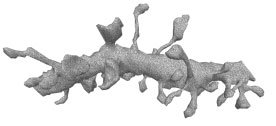Dendritic trees and active spines
 As dendrites form the predominant elements in neurons, so dendritic spines form the dominant component of many types of dendritic trees. They are small mushroom like appendages with a bulbous head and a tenuous stem and may be found in their hundreds of thousands on the dendritic tree of a single cortical pyramidal cell. These extensions of the dendritic tree provide junction points for the axons of other neurons (i.e., provide surface area for synapses), and thus serve as loci for receiving inputs (especially of the excitatory kind). Direct observations confirm earlier speculations that spine heads possess excitable channels capable of generating action potentials. As a consequence signal processing in the spatially extended dendritic tree is likely to be highly nonlinear, due to the excitable nature of spine heads. Theoretical explorations of the biophysical consequences of such nonlinearities have shown that global signals, in the form of traveling waves, may arise from a succession of local all-or-none events at the spine heads.
As dendrites form the predominant elements in neurons, so dendritic spines form the dominant component of many types of dendritic trees. They are small mushroom like appendages with a bulbous head and a tenuous stem and may be found in their hundreds of thousands on the dendritic tree of a single cortical pyramidal cell. These extensions of the dendritic tree provide junction points for the axons of other neurons (i.e., provide surface area for synapses), and thus serve as loci for receiving inputs (especially of the excitatory kind). Direct observations confirm earlier speculations that spine heads possess excitable channels capable of generating action potentials. As a consequence signal processing in the spatially extended dendritic tree is likely to be highly nonlinear, due to the excitable nature of spine heads. Theoretical explorations of the biophysical consequences of such nonlinearities have shown that global signals, in the form of traveling waves, may arise from a succession of local all-or-none events at the spine heads.
In collaboration with Gabriel Lord and Yulia Timofeeva I am investigating the effects of disordered spine distributions and dendritic branching on wave transmission and reflection.
Relevant publications:
| Y Timofeeva, S Coombes and D Michieletto 2013 Gap junctions, dendrites and resonances: a recipe for tuning network dynamics, Journal of Mathematical Neuroscience, 3:15 |
| Y Timofeeva and S Coombes 2012 Network response of gap junction coupled dendrites, Dendritic computations through morphology and connectivity, Ed. M Remme, B Torben-Nielsen, and Hermann Cuntz, Springer Series in Computational Neuroscience |
| Y Timofeeva, S J Cox, S Coombes and K Josic 2008 Democratization in a passive dendritic tree: an analytical investigation, Journal of Computational Neuroscience, Vol 25, 228-244 |
| S Coombes, Y Timofeeva, C-M Svensson, G J Lord, K Josic, S J Cox and C M Colbert 2007 Branching Dendrites with Resonant Membrane: A "sum-over-trips" approach, Biological Cybernetics, Vol 97, 137-149 |
| Y Timofeeva, G J Lord and S Coombes 2006 Dendritic cable with active spines: a modeling study in the spike-diffuse-spike framework, Neurocomputing,Vol 69, 1058-1061 |
| Y Timofeeva, G J Lord and S Coombes 2006 Spatio-temporal filtering properties of a dendritic cable with active spines, Journal of Computational Neuroscience, Vol 21, 293-306 |
| S Coombes and P C Bressloff 2003 Saltatory waves in the spike-diffuse-spike model of active dendritic spines, Physical Review Letters, Vol 91, 028102 |
| G J Lord and S Coombes 2002 Traveling waves in the Baer and Rinzel model of spine studded dendritic tissue, Physica D, Vol 161, 1-20 |
| S Coombes 2001 From periodic travelling waves to travelling fronts in the spike-diffuse-spike model of dendritic waves, Mathematical Biosciences, 170, 155-172 |
| S Coombes and P C Bressloff 2000 Solitary waves in a model of dendritic cable with active spines, SIAM J Appl Math, Vol 61, 432-453. |